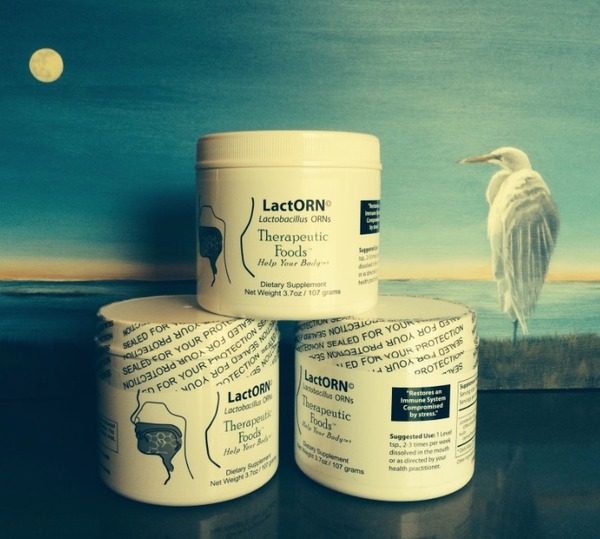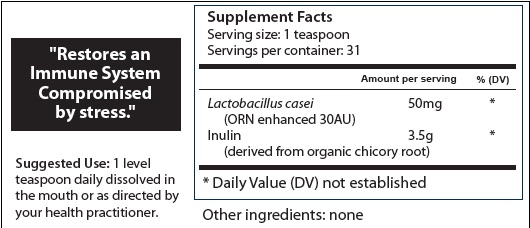Activating Probiotics
Dear Friends,
How do ORNs “activate” probiotics and modulate the immune system of animals and humans?
The LactORNs replace a nutritional ingredient lost in the Western diet due to all the processing of foods that we eat. Our bodies have evolved with ORNs from bacteria as an important component of our diet. ORNs released in our mouth activate probiotics to grow and stimulates and balances our immune systems. This has been shown in the immune systems of all animals tested—from shrimp to fish, mice, rats, pigs, cows, and humans (Marshall, 2007).
As we have learned last week, our diets lack in sufficient amounts of ORNs because we do not eat fermented foods. Furthermore, most of the yogurts and fermented vegetables available to us lack ORNs. This means that we are seriously deficient in this important nutritional element that helps our bodies fight infection.
All bacteria contain ORNs. Marshall (2007) has discovered that ORNs are small fragments of RNA weighing <10,000 Daltons. They are released immediately when bacteria are transferred from acidic culture media into saliva or pH neutral buffer.
Mice fed free <10kDaONRs released by L. casei, prior to a lethal injection of lipopolysaccharide (LPS) are protected from toxic shock death.
Exposure to <10kDaORNs stimulates innate and adaptive immune responses in hosts as diverse phylogenetically as teleosts and mammals.
In-vivo studies with shrimp and cattle show protection against infections when fed with <10kDaORNs released by Generally Recognized As Safe (GRAS) bacteria and yeasts.
The co-evolutionary release and immune modulation by exRNAs (external RNAs) appears to be well-conserved among the microbial and mammalian kingdoms.
Diets of pasteurized and processed foods do not provide sufficient amounts of GRAS organisms to release the exRNAs that modulate an immune response, nor do typical probiotics or commercial yogurts.
Since the discovery that eukaryotic cells release exRNAs that regulate expression of their genes as well as those of nearby cells, we felt it reasonable that a similar phenomenon might exist in bacteria and that the <10kDaORNs were exRNAs or transcriptional factors that control expression of their growth cycle genes.
Through co-evolution, mammalian immune cells adapted a response to them. In-vitro studies in humans as well as in-vivo studies in mice, shrimp, fish and cattle fed <10kDaORNs released by GRAS organisms significantly increased their protection against infection and the lethality of septic shock.
The L. casei doesn’t have to be cultureable but remains viable but if it is and enters a human mouth with a neutral pH of 7 then the bacteria accomplishes two things: it will release its ORNs which stimulates the oral immune system to respond, and two, the release of ORNs causes an immediate cell division by those bacteria for whom the release of ORNs has occurred when they are returned to an environment rich in nutrients.
If all the bacteria have not released their ORNs in the mouth, those that didn’t will release them when they again reach an area with an alkaline pH such as the small intestines. They start to divide and multiply with no lag time. If the pH of the mouth is more acidic than 5, only 1/3 of ORNs will be released. One can add the LactORNs to a baking soda drink (the formula can be found on the back of a box of Arm and Hammer baking soda and gargle to insure that all LactORNs are released.
There is no toxicity to the ORNs. They restore the immune system without causing chronic inflammation. The cytokines released are IL-1, IL-6, IL-4 and TNF alpha. To IL-1 and 6 control inflammation and IL-4 activates B-cells and antibody production. IL-6 seems to protect the body from too much inflammation. Overall low level of inflammation are incited to prepare the immune system for a more effective prevention of infection from bacteria and virus.
Dosage: Individuals taking prescription drugs should inform their doctors before taking LActORNS. A restored immune systme may be more sensitive to the drugs and the prescription might need to be changed. For example statins may be need to be lowered or eliminated and HBP medication may need to be reduced as well as blood thinners.
Marshall W. 2007. Oligoribonucleotides alert the immune system of animals to the imminence of microbial infections. US patent 7,189,834 B2

Sincerely yours,
Seann Bardell
BioImmersion.com
Clinical Note:
Our LactORN is the only probiotic supplement in the market that specifically grows the ORNs. Take one level teaspoon two to five times a week, depending on the weakness of the immune system. Continue to take the one of the probiotics mixes for a diverse microbial support of the GI, such as Original, No 7, or Supernatant. Add fibers such as the Beta Glucan or Energy Sustain for even a greater nutritional support.


Green Facts
Here’s more proof as to diet’s influence over our maintaining a healthy microbiome throughout our life. Just look at the elderly.
Claesson et al. (2012) state that, the gut microbiota composition correlates with diet and health in the elderly. Their microbiota composition significantly correlates with measures of frailty, co-morbidity, nutritional status, markers of inflammation and with metabolites in faecal water. The individual microbiota of people in long-stay care was significantly less diverse than that of community dwellers. Collectively, the data support a relationship between diet, microbiota and health status, and indicate a role for diet-driven microbiota alterations in varying rates of health decline upon aging.
Claesson et al. (2012). Gut microbiota composition correlates with diet and health in the elderly. Nature;488:178-184